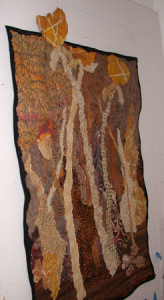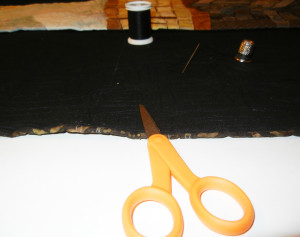I Don’t Like “Friendly” Quilts
And by that I mean quilts that are so friendly they’re waving. Or curling. I’m not a fan.
Like this quilt (shot from an angle.) The sides are supposed to be straight and flat.
Click any image for a larger view
I know there’s some debate about whether or not art quilts should be expected to hang flat against the wall. But, I come down firmly on the side of “Yes, they should!” To me, a quilt that waves, or flares out from the wall is like a painting with a dented canvas or a cracked frame. Such things are very distracting, and in my opinion, they actually detract from the art.
That’s why I typically block my quilts. This is a process of pinning a quilt to it’s proper shape and then steaming it so it stays that way. I’ve written an article about it on my website.
But, let’s back up a bit and discuss the cause of all these “friendly” quilts. It’s generally caused by machine quilting, especially if the density of the stitching varies throughout the piece. Some forethought will sometimes make it possible to alter the quilting plan in order to avoid this.
If not, I’ve had great luck with blocking. Some people suggest that it’s a temporary fix which will last only until the humidity climbs. Since I live in hot and humid Florida, I think the quilts hanging on my walls are a perfect testing ground for this idea. My observation: the quilts generally stay flat. I will sometimes notice a little curling on the sides, which I can ease back into place with my hands. (And when I say sometimes, I mean every few years.) Also, I have had to reblock a few quilts if they were tightly folded and packed for shipping.
Recently, I made a quilt that had some very uneven quilting. (See below.)
I quilted around every stone in the wall, making the stitching much more dense on the left than the right. I definitely had waving, but I wasn’t worried about it since I knew I could count on blocking. But, for the first time ever, it wasn’t enough. The right side was still waving a little.
My solution was twofold. First, I added a lot more quilting to the right side, using clear thread. That pretty much took care of it. But, because I avoided stitching in the outside 1/4″ (due to the bulk of the facing seam allowance,) it still had a tiny ripple right at the very edge. So, I turned to something new.
Following the blog instructions offered by Alison Schwabe, I bascially gathered up the edge of the quilt. To do so, I used heavy thread and hand stitched a line of running stitches all along the edge. I kept the stitching buried in the batting, invisible from both front and back. Initially, I left the ends of the thread loose and with long tails. Then, I gathered the quilt along that thread, drawing it up until it laid flat. Finally, I anchored the threads with tacking stitches.
Here’s the edge before and after. To the right of the scissors, the gathering has been completed. But, left of the scissors, the ripple still exists.
The bottom line: I like flat quilts and will work to make mine so.
How do you feel about friendly quilts?
Do you have other techniques that you use?
Ellen Lindner



Wow, Ellen, that is an interesting way to make it lay flat. I never would have thought of it. I usually block it before I square it up and sew on the binding. That seems to work really well. Also I try to make the quilting fairly uniform which helps.
I agree that wall quilts should lie flat. I do not like wavy quilts.
Chris
I usually “ease” the quilt into the binding, gently. Works most of the time. I’m happy to read about your alturnatives, should the easing not work. Thabk you. Lee
Thanks Ellen for that new idea. Sounds good.
I do not like wavy quilts either. I also steam block mine on my design wall. But before I put on the binding, I use the measurement from the middle of the length and middle of the width and then cut my binding that measurement, so if there is fabric that will wave in there, it will be eased in with when I stitch on the binding. Hope that was clear enough.
Susan
Thanks for all the feedback and suggestions!